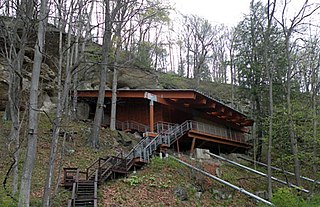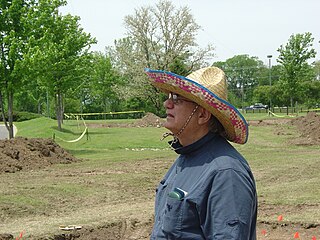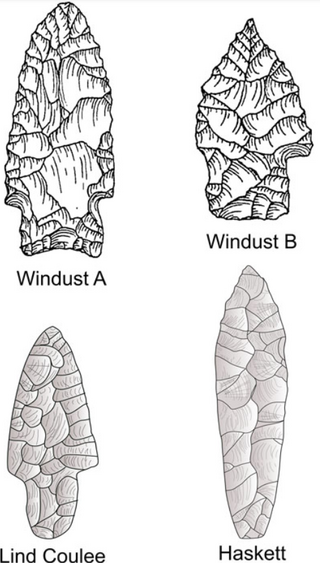
In the History of Mesoamerica, the stage known as the Paleo-Indian period is the era in the scheme of Mesoamerican chronology which begins with the very first indications of human habitation within the Mesoamerican region, and continues until the general onset of the development of agriculture and other proto-civilisation traits. The conclusion of this stage may be assigned to approximately 9000 BP, and the transition to the succeeding Archaic period is not a well-defined one.

The Clovis culture is an archaeological culture from the Paleoindian period of North America, spanning around 13,050 to 12,750 years Before Present. The type site is Blackwater Draw locality No. 1 near Clovis, New Mexico, where stone tools were found alongside the remains of Columbian mammoths in 1929. Clovis sites have been found across North America. The most distinctive part of the Clovis culture toolkit are Clovis points, which are projectile points with a fluted, lanceolate shape. Clovis points are typically large, sometimes exceeding 10 centimetres (3.9 in) in length. These points were multifunctional, also serving as cutting tools. Other stone tools used by the Clovis culture include knives, scrapers and bifacial tools, with bone tools including beveled rods and shaft wrenches, with possible ivory points also being identified. Hides, wood, and natural fibres may also have been heavily utilized, though no direct evidence of this has been preserved. Clovis artifacts are often found grouped together in caches where they had been stored for later retrieval, and over 20 Clovis caches have been identified.

Paleo-Indians were the first peoples who entered and subsequently inhabited the Americas towards the end of the Late Pleistocene period. The prefix paleo- comes from the Ancient Greek adjective: παλαιός, romanized: palaiós, lit. 'old; ancient'. The term Paleo-Indians applies specifically to the lithic period in the Western Hemisphere and is distinct from the term Paleolithic.
The Buhl Woman was an Paleoindian Indigenous American woman whose remains were found in a quarry near Buhl, Idaho, United States, in January 1989. The remains are though to have been deliberately buried. Radiocarbon dating has placed the age of the skeleton at 12,740–12,420 calibrated years before present, making her remains some of the oldest in the Americas, though the quality of the dating has been questioned.

The Meadowcroft Rockshelter is an archaeological site which is located near Avella in Jefferson Township, Pennsylvania. The site is a rock shelter in a bluff overlooking Cross Creek, and contains evidence that the area may have been continually inhabited for more than 19,000 years. If accurately dated, it would be one of the earliest known sites with evidence of a human presence and continuous human occupation in the New World.

James M. Adovasio is an American archaeologist and one of the foremost experts in perishable artifacts. He was formerly the Provost, Dean of the Zurn School of Natural Sciences and Mathematics, and Director of the Mercyhurst Archaeological Institute at Mercyhurst University in Erie, Pennsylvania, Adovasio is best known for his work at Meadowcroft Rockshelter in Pennsylvania and for his subsequent role in the "Clovis First" debate. He has published nearly 400 books, monographs, articles, and papers in his field.

Fort Rock Cave was the site of the earliest evidence of human habitation in the US state of Oregon before the excavation of the Paisley Caves. Fort Rock Cave featured numerous well-preserved sagebrush sandals, ranging from 9,000 to 13,000 years old. The cave is located approximately 1.5 miles (2.4 km) west of Fort Rock near Fort Rock State Natural Area in Lake County. Fort Rock Cave was declared a National Historic Landmark in 1961, and added to the National Register of Historic Places in 1966.

The Paisley Caves or the Paisley Five Mile Point Caves complex is a system of eight caves in an arid, desolate region of south-central Oregon, United States north of the present-day city of Paisley, Oregon. The caves are located in the Summer Lake basin at 4,520 feet (1,380 m) elevation and face west, carved into a ridge of Miocene and Pliocene era basalts mixed with soft volcanic tuffs and breccias by Pleistocene-era waves from Summer Lake. One of the caves may contain archaeological evidence of the oldest definitively-dated human presence in North America. The site was first studied by Luther Cressman in the 1930s.
J&J Hunt Site (8JE740) is an inundated prehistoric archaeological site located 6 km off the coast of northwestern Florida. The site which was discovered in 1989 is located in 3.7 to 4.6 m of salt water in the Gulf of Mexico along the PaleoAucilla River. In prehistory the site had at least two different occupations: a Late Paleoindian-Early Archaic and Middle Archaic. The J&J Hunt site was a major focus of the PaleoAucilla Prehistory Project conducted by Michael K. Faught.

Cueva Fell or Fell'sCave is a natural cave and archaeological site in southern Patagonia. Cueva Fell is in proximity to the Pali Aike Crater, another significant archaeological site. Cueva Fell combined with the nearby Pali Aike site have been submitted to UNESCO as a possible World Heritage Site.
Pendejo Cave is a geological feature and archaeological site located in southern New Mexico about 20 miles east of Orogrande. Archaeologist Richard S. MacNeish claimed that human occupation of the cave pre-dates by tens of thousands of years the Clovis Culture, traditionally believed to be one of the oldest if not the oldest culture in the Americas.
Hell Gap is a deeply stratified archaeological site located in the Great Plains of eastern Wyoming, approximately thirteen miles north of Guernsey, where an abundant amount of Paleoindian and Archaic artifacts have been found and excavated since 1959. This site has had an important impact on North American archaeology because of the large quantity and breadth of prehistoric Paleoindian and Archaic period artifacts and cultures it encompasses. It was designated a National Historic Landmark in 2016.

John Bertram Broster is an American archaeologist formerly serving as the Prehistoric Archeological Supervisor at the Tennessee Division of Archaeology, Department of Environment and Conservation. He is best known for his work on the Paleoindian period of the American Southwest and Southeast, and has published some 38 book chapters and journal articles on the subject.

The Gault archaeological site is an extensive, multicomponent site located in Florence, Texas, United States on the Williamson-Bell County line along Buttermilk Creek about 250 meters upstream from the Buttermilk Creek complex. It bears evidence of human habitation for at least 20,000 years, making it one of the few archaeological sites in the Americas at which compelling evidence has been found for human occupation dating to before the appearance of the Clovis culture. Archaeological material covers about 16 hectares with a depth of up to 3 meters in places. About 30 incised stones from the Clovis period engraved with geometric patterns were found there as well as others from periods up to the Early Archaic. Incised bone was also found.
The Anzick site (24PA506), located adjacent to Flathead Creek, a tributary of the Shields River in Wilsall, Park County, Montana, United States, is the only known Clovis burial site in the New World. The term "Clovis" is used by archaeologists to define one of the New World's earliest hunter-gatherer cultures and is named after the site near Clovis, New Mexico, where human artifacts were found associated with the procurement and processing of mammoth and other large and small fauna.
The coastal migration hypothesis is one of two leading hypotheses about the settlement of the Americas at the time of the Last Glacial Maximum. It proposes one or more migration routes involving watercraft, via the Kurile island chain, along the coast of Beringia and the archipelagos off the Alaskan-British Columbian coast, continuing down the coast to Central and South America. The alternative is the hypothesis solely by interior routes, which assumes migration along an ice-free corridor between the Laurentide and Cordilleran ice sheets during the Last Glacial Maximum.

Cooper's Ferry is an archaeological site along the lower Salmon River near the confluence with Rock Creek in the western part of the US state of Idaho, and part of the Lower Salmon River Archeological District. It is 17 kilometres (11 mi) south of the town of Cottonwood and 63 kilometres (39 mi) upstream from the Snake River. Various lithic and animal remains from the Pleistocene to early Holocene ages have been found there. The site is on traditional Nez Perce land, and known to the tribe as the historical village of Nipéhe.

Rimrock Draw Rockshelter is a rockshelter located in Eastern Oregon of the US. It is an archaeological site being studied by the University of Oregon under the guidance of Dr. Patrick O'Grady in coordination with the Museum of Natural and Cultural History and in partnership with the Bureau of Land Management (BLM).
The theory known as "Clovis First" was the predominant hypothesis among archaeologists in the second half of the 20th century to explain the peopling of the Americas. According to Clovis First, the people associated with the Clovis culture were the first inhabitants of the Americas. This hypothesis came to be challenged by ongoing studies that suggest pre-Clovis human occupation of the Americas. In 2011, following the excavation of an occupation site at Buttermilk Creek, Texas, a group of scientists identified the existence "of an occupation older than Clovis." At the site in Buttermilk, archaeologists discovered evidence of hunter-gatherer group living and the making of projectile spear points, blades, choppers, and other stone tools. The tools found were made from a local chert and could be dated back to as early as 15,000 years ago.

The Western Stemmed Tradition (WST) is a Paleoindian archaeological culture known from the Intermountain West of North America, particularly the Great Basin and the Columbian Plateau, spanning from over 13,000 years Before Present to around 8,500 years Before Present. Unlike Clovis and related traditions, the stone projectile points produced by the Western Stemmed Tradition are unfluted. Other types of tool produced by WST peoples include stone crescents. The Western Stemmed Tradition has a wide variability in tool morphology, and is divided up into a number of chronologically separated subtypes, including the Haskett, Cougar Mountain Parman and Windust. Some of the oldest sites of the tradition are at Cooper's Ferry in Idaho and Paisley Cave in Oregon, dating to the Bølling–Allerød Interstadial.













